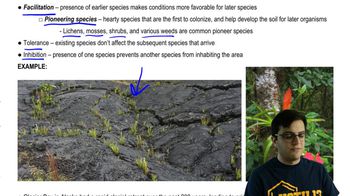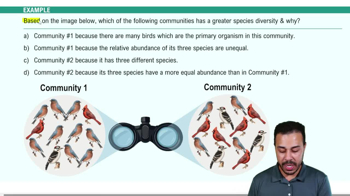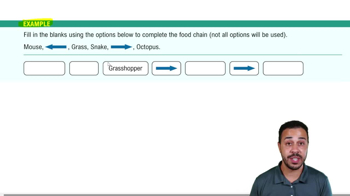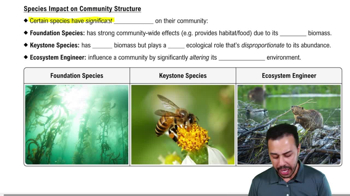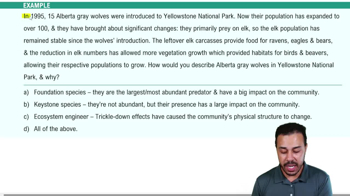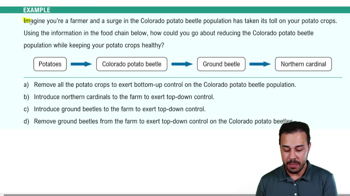Table of contents
- 1. Introduction to Biology2h 42m
- 2. Chemistry3h 40m
- 3. Water1h 26m
- 4. Biomolecules2h 23m
- 5. Cell Components2h 26m
- 6. The Membrane2h 31m
- 7. Energy and Metabolism2h 0m
- 8. Respiration2h 40m
- 9. Photosynthesis2h 49m
- 10. Cell Signaling59m
- 11. Cell Division2h 47m
- 12. Meiosis2h 0m
- 13. Mendelian Genetics4h 44m
- Introduction to Mendel's Experiments7m
- Genotype vs. Phenotype17m
- Punnett Squares13m
- Mendel's Experiments26m
- Mendel's Laws18m
- Monohybrid Crosses19m
- Test Crosses14m
- Dihybrid Crosses20m
- Punnett Square Probability26m
- Incomplete Dominance vs. Codominance20m
- Epistasis7m
- Non-Mendelian Genetics12m
- Pedigrees6m
- Autosomal Inheritance21m
- Sex-Linked Inheritance43m
- X-Inactivation9m
- 14. DNA Synthesis2h 27m
- 15. Gene Expression3h 20m
- 16. Regulation of Expression3h 31m
- Introduction to Regulation of Gene Expression13m
- Prokaryotic Gene Regulation via Operons27m
- The Lac Operon21m
- Glucose's Impact on Lac Operon25m
- The Trp Operon20m
- Review of the Lac Operon & Trp Operon11m
- Introduction to Eukaryotic Gene Regulation9m
- Eukaryotic Chromatin Modifications16m
- Eukaryotic Transcriptional Control22m
- Eukaryotic Post-Transcriptional Regulation28m
- Eukaryotic Post-Translational Regulation13m
- 17. Viruses37m
- 18. Biotechnology2h 58m
- 19. Genomics17m
- 20. Development1h 5m
- 21. Evolution3h 1m
- 22. Evolution of Populations3h 52m
- 23. Speciation1h 37m
- 24. History of Life on Earth2h 6m
- 25. Phylogeny2h 31m
- 26. Prokaryotes4h 59m
- 27. Protists1h 12m
- 28. Plants1h 22m
- 29. Fungi36m
- 30. Overview of Animals34m
- 31. Invertebrates1h 2m
- 32. Vertebrates50m
- 33. Plant Anatomy1h 3m
- 34. Vascular Plant Transport1h 2m
- 35. Soil37m
- 36. Plant Reproduction47m
- 37. Plant Sensation and Response1h 9m
- 38. Animal Form and Function1h 19m
- 39. Digestive System1h 10m
- 40. Circulatory System1h 57m
- 41. Immune System1h 12m
- 42. Osmoregulation and Excretion50m
- 43. Endocrine System1h 4m
- 44. Animal Reproduction1h 2m
- 45. Nervous System1h 55m
- 46. Sensory Systems46m
- 47. Muscle Systems23m
- 48. Ecology3h 11m
- Introduction to Ecology20m
- Biogeography14m
- Earth's Climate Patterns50m
- Introduction to Terrestrial Biomes10m
- Terrestrial Biomes: Near Equator13m
- Terrestrial Biomes: Temperate Regions10m
- Terrestrial Biomes: Northern Regions15m
- Introduction to Aquatic Biomes27m
- Freshwater Aquatic Biomes14m
- Marine Aquatic Biomes13m
- 49. Animal Behavior28m
- 50. Population Ecology3h 41m
- Introduction to Population Ecology28m
- Population Sampling Methods23m
- Life History12m
- Population Demography17m
- Factors Limiting Population Growth14m
- Introduction to Population Growth Models22m
- Linear Population Growth6m
- Exponential Population Growth29m
- Logistic Population Growth32m
- r/K Selection10m
- The Human Population22m
- 51. Community Ecology2h 46m
- Introduction to Community Ecology2m
- Introduction to Community Interactions9m
- Community Interactions: Competition (-/-)38m
- Community Interactions: Exploitation (+/-)23m
- Community Interactions: Mutualism (+/+) & Commensalism (+/0)9m
- Community Structure35m
- Community Dynamics26m
- Geographic Impact on Communities21m
- 52. Ecosystems2h 36m
- 53. Conservation Biology24m
51. Community Ecology
Community Structure
Problem 10`
Textbook Question
About a third of insect species measured are in decline, meaning that their populations are shrinking due to habitat destruction, pollution, and other factors. Predict how this change affects the bee pollination of crops such as apples and almonds.
 Verified step by step guidance
Verified step by step guidance1
Understand the role of bees in pollination: Bees are key pollinators for many crops, including apples and almonds. Pollination is the process where pollen is transferred from the male part of a flower (anther) to the female part (stigma), enabling fertilization and fruit production.
Recognize the impact of insect population decline: A decrease in bee populations due to habitat destruction, pollution, and other factors reduces the number of pollinators available to perform this essential function.
Analyze the consequences for crop production: With fewer bees available to pollinate crops, the efficiency of pollination decreases, potentially leading to lower yields of fruits like apples and almonds.
Consider secondary effects: Reduced crop yields can impact food supply, economic stability for farmers, and biodiversity in ecosystems that depend on these crops.
Predict long-term implications: If the decline in insect populations continues, it may necessitate alternative pollination strategies, such as manual pollination or reliance on other pollinator species, which could be less effective or more costly.
 Verified video answer for a similar problem:
Verified video answer for a similar problem:This video solution was recommended by our tutors as helpful for the problem above
Video duration:
1mPlay a video:
Was this helpful?
Key Concepts
Here are the essential concepts you must grasp in order to answer the question correctly.
Pollination
Pollination is the process by which pollen is transferred from the male anthers of a flower to the female stigma, enabling fertilization and the production of seeds. Insects, particularly bees, are crucial pollinators for many crops, including apples and almonds. Their activity directly influences fruit set and yield, making their decline a significant concern for agricultural productivity.
Recommended video:
Guided course
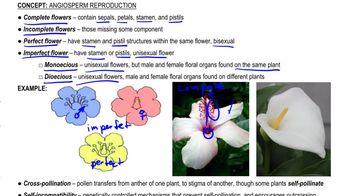
Pollination
Ecosystem Services
Ecosystem services are the benefits that humans derive from natural ecosystems, including food production, pollination, and climate regulation. Pollinators like bees provide essential services by facilitating the reproduction of flowering plants, which in turn supports food systems and biodiversity. A decline in pollinator populations can disrupt these services, leading to reduced crop yields and economic losses.
Recommended video:
Guided course
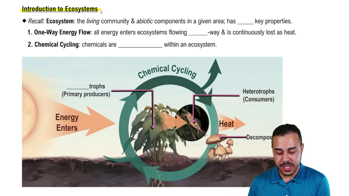
Introduction to Ecosystems
Biodiversity and Resilience
Biodiversity refers to the variety of life in a particular habitat or ecosystem, including the diversity of species, genetic variation, and ecosystem processes. High biodiversity contributes to ecosystem resilience, allowing systems to withstand environmental changes and disturbances. The decline of insect species, particularly pollinators, can reduce biodiversity, weakening ecosystem resilience and potentially leading to crop failures and food insecurity.
Recommended video:
Guided course

Biodiversity and Sustainability
Related Videos
Related Practice








